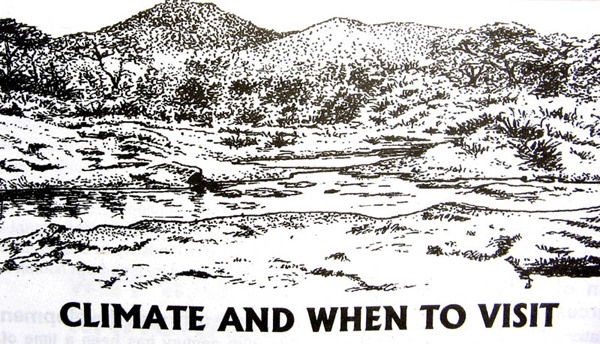
There is an obvious yet gradual transition from wetter areas in the South of the park, characterised by rainforests and mountains; to drier, lowland areas in the North of the park which characteristically are only able to support savannah-like vegetation.
Climate in the village of Gashaka
|
YEARS |
JAN |
FEB |
MAR |
APR |
MAY |
JUN |
JUL |
AUG |
SEP |
OCT |
NOV |
DEC |
Mean or Total |
|
Coolest day (degree Celsius) |
12 |
12 |
16 |
16 |
16 |
19 |
19 |
19 |
20 |
18 |
16 |
13 |
12 |
|
Hottest day (degree Celsius) |
37 |
42 |
41 |
42 |
38 |
36 |
36 |
36 |
34 |
37 |
36 |
34 |
42 |
|
Mean max. (degree Celsius) |
32 |
35 |
36 |
35 |
33 |
32 |
31 |
30 |
30 |
30 |
31 |
31 |
32.5 |
|
Mean min. temp. (degree Celsius) |
16 |
19 |
22 |
23 |
22 |
22 |
23 |
22 |
22 |
22 |
21 |
17 |
21.0 |
|
Mean humidity (%) |
33 |
26 |
31 |
53 |
67 |
72 |
74 |
76 |
78 |
76 |
55 |
39 |
58 |
|
Rain days / month (%) |
0 |
1 |
4 |
38 |
52 |
59 |
63 |
59 |
69 |
58 |
12 |
0 |
35 |
|
Wettest day (mm rain) |
0 |
8 |
41 |
43 |
103 |
69 |
99 |
152 |
114 |
78 |
56 |
0 |
152 |
|
Rain (mm) |
0 |
2 |
15 |
133 |
214 |
227 |
251 |
363 |
333 |
273 |
52 |
0 |
1897 |
Temperatures
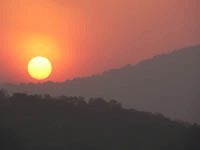
At the beginning of the dry season, and at any time of the year at higher altitudes, visitors should be prepared for cold weather. Although daytime temperatures may reach 40 degrees C in the shade in March, they may equally drop to below 5 degrees C at higher altitudes in December. Sudden storms and hailstones are commonplace on the mountain of Gangirwal.
Rainfall
Rain does not fall evenly throughout the year; there is typically a “wet season” comprising those months when there is a lot of rain and many rainy days, and a “dry season” when little or no rains falls and there are few, if any, rainy days.
The Wet Season
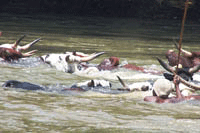
This season is heralded in and out by a brief period of squalls and violent storms with strong winds and heavy, brief downpours likely. At Gashaka-Gumti virtually all rain falls between the months of April through to November although the timing and amount of rain falling in any one year is highly variable. The local climate is further influenced by topography, with different regions of the National Park receiving very dissimilar amounts of rainfall depending on location and altitude.
The wettest areas of the park are located in the mountain ranges of the Southern park sector that face the prevailing South-westerly moisture laden winds blowing off the Atlantic Ocean. The forested basin below Chappal Waddi, for example, probably receives rainfall in excess of 3000 millimetres annually. The driest park regions are located further to the North where the rainy season is shorter, usually only lasting from May to October. Here the average annual rainfall may be as low as 1300 millimetres.
The Dry Season
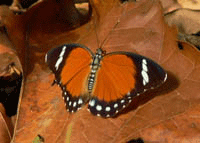
Typically from December to March it is dry everywhere. The early period of this season is further characterised by the dry, sand-laden Harmattan winds blowing down from the North-east off the Sahara Desert. Severe atmospheric aridity and great extremes of temperatures are experienced at this time of year.
Visiting the National Park During the Wet Season
Although the wet season does present certain unique challenges this should not prevent anyone from visiting the park at this time of year. The wet season has its own particular advantages: temperatures are cooler at this time of year and the park looks fresh and green. Moreover the wet season is an ideal time for observing rainforest animals, birds and butterflies, whatever the weather. Although vehicular access into the park is restricted during the wet season, when many rivers become flooded and swollen, it is always possible to reach the village of Gashaka whatever the time of year, and from there continue on into the park on foot.
Visiting the National Park During the Dry Season
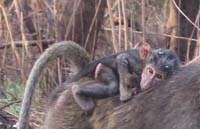
The dry season represents the main season for tourism at Gashaka-Gumti. This is the best time of year for sport fishing and game viewing. Access and visibility are good although it can be very hot late in the dry season. Temperatures during the early dry season are more pleasant due to the Harmattan winds although visibility can be hazy as a result.
When is the National Park Open?
Gashaka-Gumti National Park is open to visitors all year round.
